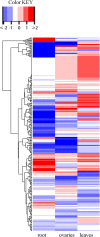Identification of candidate genes for drought tolerance by whole-genome resequencing in maize
- PMID: 24684805
- PMCID: PMC4021222
- DOI: 10.1186/1471-2229-14-83
Identification of candidate genes for drought tolerance by whole-genome resequencing in maize
Abstract
Background: Drought stress is one of the major limiting factors for maize production. With the availability of maize B73 reference genome and whole-genome resequencing of 15 maize inbreds, common variants (CV) and clustering analyses were applied to identify non-synonymous SNPs (nsSNPs) and corresponding candidate genes for drought tolerance.
Results: A total of 524 nsSNPs that were associated with 271 candidate genes involved in plant hormone regulation, carbohydrate and sugar metabolism, signaling molecules regulation, redox reaction and acclimation of photosynthesis to environment were detected by CV and cluster analyses. Most of the nsSNPs identified were clustered in bin 1.07 region that harbored six previously reported QTL with relatively high phenotypic variation explained for drought tolerance. Genes Ontology (GO) analysis of candidate genes revealed that there were 35 GO terms related to biotic stimulus and membrane-bounded organelle, showing significant differences between the candidate genes and the reference B73 background. Changes of expression level in these candidate genes for drought tolerance were detected using RNA sequencing for fertilized ovary, basal leaf meristem tissue and roots collected under drought stressed and well-watered conditions. The results indicated that 70% of candidate genes showed significantly expression changes under two water treatments and our strategies for mining candidate genes are feasible and relatively efficient.
Conclusions: Our results successfully revealed candidate nsSNPs and associated genes for drought tolerance by comparative sequence analysis of 16 maize inbred lines. Both methods we applied were proved to be efficient for identifying candidate genes for complex traits through the next-generation sequencing technologies (NGS). These selected genes will not only facilitate understanding of genetic basis of drought stress response, but also accelerate genetic improvement through marker-assisted selection in maize.
Figures







Similar articles
-
Genomic basis underlying the metabolome-mediated drought adaptation of maize.Genome Biol. 2021 Sep 6;22(1):260. doi: 10.1186/s13059-021-02481-1. Genome Biol. 2021. PMID: 34488839 Free PMC article.
-
Numerous genetic loci identified for drought tolerance in the maize nested association mapping populations.BMC Genomics. 2016 Nov 8;17(1):894. doi: 10.1186/s12864-016-3170-8. BMC Genomics. 2016. PMID: 27825295 Free PMC article.
-
Genome-wide transcriptional analysis of two soybean genotypes under dehydration and rehydration conditions.BMC Genomics. 2013 Oct 6;14:687. doi: 10.1186/1471-2164-14-687. BMC Genomics. 2013. PMID: 24093224 Free PMC article.
-
Genetic, molecular and physiological crosstalk during drought tolerance in maize (Zea mays): pathways to resilient agriculture.Planta. 2024 Aug 28;260(4):81. doi: 10.1007/s00425-024-04517-9. Planta. 2024. PMID: 39196449 Review.
-
Meta-analysis and candidate gene mining of low-phosphorus tolerance in maize.J Integr Plant Biol. 2014 Mar;56(3):262-70. doi: 10.1111/jipb.12168. Epub 2014 Feb 26. J Integr Plant Biol. 2014. PMID: 24433531 Review.
Cited by
-
A Gene Regulatory Network Controlled by BpERF2 and BpMYB102 in Birch under Drought Conditions.Int J Mol Sci. 2019 Jun 23;20(12):3071. doi: 10.3390/ijms20123071. Int J Mol Sci. 2019. PMID: 31234595 Free PMC article.
-
Profiling of drought-responsive microRNA and mRNA in tomato using high-throughput sequencing.BMC Genomics. 2017 Jun 26;18(1):481. doi: 10.1186/s12864-017-3869-1. BMC Genomics. 2017. PMID: 28651543 Free PMC article.
-
A Dual Strategy of Breeding for Drought Tolerance and Introducing Drought-Tolerant, Underutilized Crops into Production Systems to Enhance Their Resilience to Water Deficiency.Plants (Basel). 2020 Sep 24;9(10):1263. doi: 10.3390/plants9101263. Plants (Basel). 2020. PMID: 32987964 Free PMC article. Review.
-
Identification of QTN-by-environment interactions for yield related traits in maize under multiple abiotic stresses.Front Plant Sci. 2023 Feb 15;14:1050313. doi: 10.3389/fpls.2023.1050313. eCollection 2023. Front Plant Sci. 2023. PMID: 36875585 Free PMC article.
-
Research Progress and Perspective on Drought Stress in Legumes: A Review.Int J Mol Sci. 2019 May 23;20(10):2541. doi: 10.3390/ijms20102541. Int J Mol Sci. 2019. PMID: 31126133 Free PMC article. Review.
References
-
- Ribaut J-M, Betran J, Monneveux P, Setter T. In: Handbook of Maize: Its Biology. Bennetzen Jeff L, Hake Sarah C, editor. New York: Springer; 2009. Drought tolerance in maize; pp. 311–344.
-
- Shinozaki K, Yamaguchi-Shinozaki K. Gene networks involved in drought stress response and tolerance. J Exper Botany. 2007;58(2):221–227. - PubMed
-
- Lu Y, Zhang S, Shah T, Xie C, Hao Z, Li X, Farkhari M, Ribaut JM, Cao M, Rong T. Joint linkage–linkage disequilibrium mapping is a powerful approach to detecting quantitative trait loci underlying drought tolerance in maize. Proc Natl Acad Sci. 2010;107(45):19585–19590. doi: 10.1073/pnas.1006105107. - DOI - PMC - PubMed
Publication types
MeSH terms
Substances
LinkOut - more resources
Full Text Sources
Other Literature Sources

